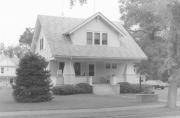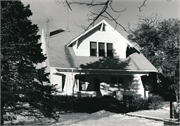Property Record
256 WISCONSIN AVE
Architecture and History Inventory
| Historic Name: | Rudolph and Sarah Peterson House |
|---|---|
| Other Name: | Vallejo |
| Contributing: | |
| Reference Number: | 4215 |
| Location (Address): | 256 WISCONSIN AVE |
|---|---|
| County: | Burnett |
| City: | Grantsburg |
| Township/Village: | |
| Unincorporated Community: | |
| Town: | |
| Range: | |
| Direction: | |
| Section: | |
| Quarter Section: | |
| Quarter/Quarter Section: |
| Year Built: | 1920 |
|---|---|
| Additions: | |
| Survey Date: | 1978 |
| Historic Use: | house |
| Architectural Style: | Bungalow |
| Structural System: | |
| Wall Material: | Clapboard |
| Architect: | LEWIS HOMES CO |
| Other Buildings On Site: | |
| Demolished?: | No |
| Demolished Date: |
| National/State Register Listing Name: | Not listed |
|---|---|
| National Register Listing Date: | |
| State Register Listing Date: |
| Additional Information: | A 'site file' exists for this property. It contains additional information such as correspondence, newspaper clippings, or historical information. It is a public record and may be viewed in person at the Wisconsin Historical Society, Division of Historic Preservation. ELEPHANTINE PILLARS ON PORCHLEWIS HOMES CO "THE VALLEJO" The popularity of the Craftsman bungalow coincided with the expansion of the middle class, the growth of suburbs and mass consumerism, and the spirit of the Progressive Era. Mail-order house-kits like those available from the Lewis Manufacturing Company of Bay City, Michigan, contributed to the bungalow’s popularity. The company’s slogan--“Direct to you cuts costs in two”--telegraphed images of efficiency and thrift, Progressive watchwords. Vertically integrated, the corporation owned its own forests, saw mills, lumber yards, cutting mills, and finishing mills in Michigan’s timber country. The prospective homeowner could purchase a kit for a Craftsman bungalow of two bedrooms or a deluxe model, complete with beamed ceilings, a formal dining room, a separate breakfast room, and a den. The buyer had to supply the plot of land, lay the foundation, and hire a carpenter, but the Lewis company provided nearly everything else. Building materials came pre-cut, numbered and keyed to the blue prints. Everything was included--even the nails and paint--except the plumbing fixtures, the foundation, and the chimney. In addition to the blue prints and elevation drawings, an instruction manual explained each operation, from unloading materials from the railroad boxcar to painting the house. Around 1920, Rudolph and Sarah Peterson selected the Vallejo, one of the company’s finest clapboard houses, priced at $1,190, the equivalent of only $11,000 today. A side-gabled roof sweeps out gracefully to shelter the full-width porch. The porch’s wing walls form a base for wide, tapered columns supporting the roof. Vertical wooden strips along the face of these columns accentuate the tapering, creating “harmony of dimension and design,” according to the catalog. An oversized gabled dormer dominates the facade. A group of three windows with narrow, vertical panes in the upper sashes partially fill the dormer and illuminate each of the rooms. These provided the fresh air and natural light that Progressive reformers believed were important to good health and a happy family life. |
|---|---|
| Bibliographic References: | SCHWEITZER AND DAVIS, AMERICA'S FAVORITE HOUSES, P 157 Buildings of Wisconsin manuscript. |
| Wisconsin Architecture and History Inventory, State Historic Preservation Office, Wisconsin Historical Society, Madison, Wisconsin |


